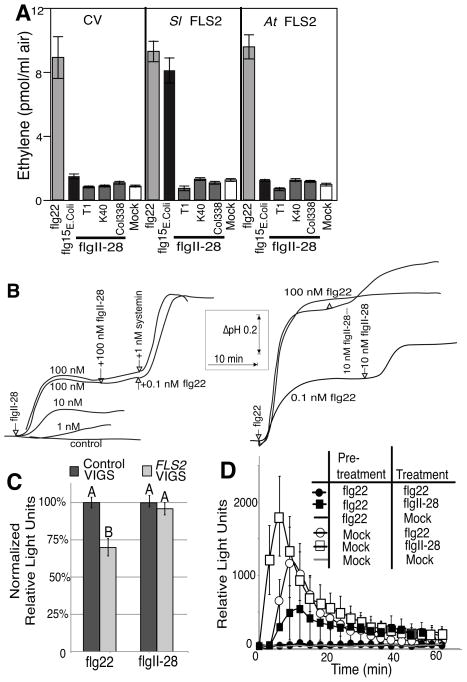Fig. 4.
Tomato FLS2 is not sufficient for perception of flgII-28T1. (a)Transient expression of FLS2 in Nicotiana benthamiana does not lead to the detection of flgII-28T1. Leaf punches from leaves agrotransformed with control vector (CV), tomato FLS2 (Sl FLS2) and Arabidopsis FLS2 (At FLS2) were treated with indicated peptides at 1μM concentration and total ethylene production was measured 3.5 h after treatment. Data shown are the average of 6 replicates; error bars represent ± SE. (b) Alkalinization of extracellular pH in cell cultures derived from the wild tomato species peruvianum to treatment with the peptides flgII-28T1, flg22, and systemin. (c) The oxidative burst triggered by 10nM flg22 (grey bars) or 10nM flgII-28T1 (white bars) was quantified in S. lycopersicum cv ‘Rio Grande’ silenced for the flagellin receptor FLS2 (n=48; 6 experiments) or the flagellin co-receptor Bak1 (n=18; 3 experiments) compared to non-silenced control plants (n=48; 6 experiments). Total reactive oxygen species (ROS) production was measured over a 45 min time period, and the average of 3–4 leaf disks per plant was calculated. Bar values represent the normalized mean and the error bars ± SE. The statistical significance between silenced and control plants for each peptide treatment was assessed using Student’s t-test with the alpha level 0.005. (d) Leaf punches of 4-wk-old tomato cv ‘Rio Grande’ were treated with either 1μM of flg22 or H2O (mock) as indicated and then 50 min later treated with indicated peptides and ROS was measured for 1 h immediately following treatment. Similar results were obtained in 4 independent experiments. Data shown are the average of 6 replicate leaves.

